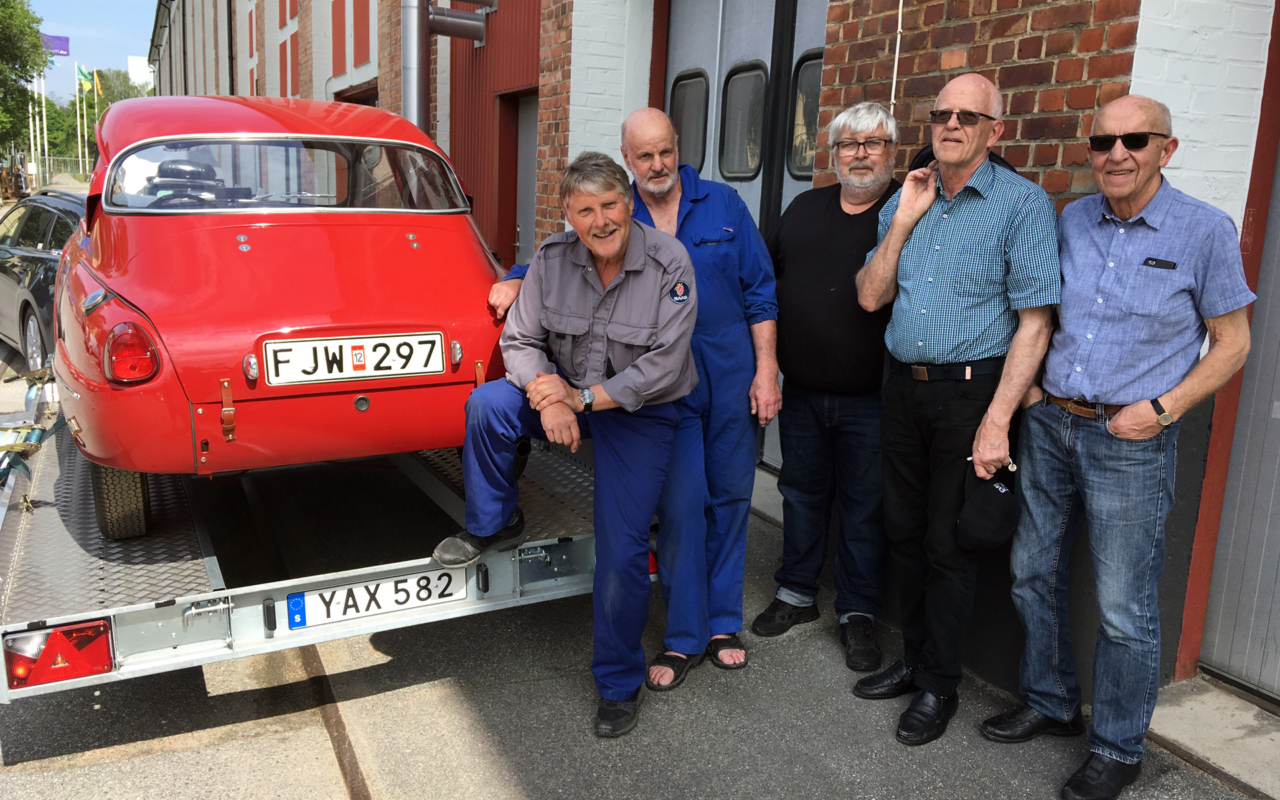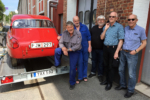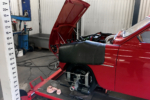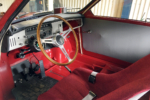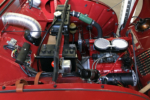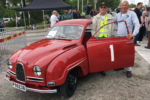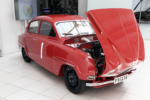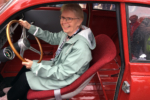Juni 2019 – Premiere at the Saab Car Museum Festival
Throughout May 2019, some rather intensive work was needed to complete the Group 3 project cars exhaust and fuel-system. Work started by installing the special front silencer which had been built according to Saabs competitions departments specifications by local legend Evert Karlsson from Sjuntorp. This followed by the fitment of a 2-inch dia. intermediate exhaust pipe and a standard rear silencer. A special adaptor flange was included in the intermediate exhaust pipe permitting, when needed, the fitment of the shorter straight out exhaust pipe, opening under the right-hand sill, behind the passenger door. In the 60s no one talked about noise restrictions, in those days race cars had to sound sporty!
Several intricate problems were however encountered with the fuel system which unfortunately delaying progress of the project by several weeks. After waiting 6 months for delivery of special filters for the Saab 92 twin Solex carburettor, Björknäs Saab Parts managed to supply us with two similar air filters which required only a minor adjustment to complete the air cleaner installation. On our project car, fuel from the fuel tank is required to be supplied to two brand new S.U. fuel pumps and forward to the twin Solex carburettor. In original specification the G3 car had metal-bound fuel lines which were prone to leakage once they had been bent. For safety reasons such fuel lines are not recommended for use today. Our sponsor Vikens Maskin in Uddevalla later supplied us with fuel line connections and modern metal bound fuel lines very similar to the original fuel lines on the competition cars.
The next task was to find suitably sized banjo connections for the fuel lines to be connected to the carburettor. With no response for our search in Sweden we managed eventually to find a supplier in Germany. Although being able to complete the cars fuel supply system a further problem arose with the carburettor itself. Originally used on a Porsche, was received unassembled. Once the correct assembly drawings had been located several hours had elapsed before work could begin assembling all the individual components needed to complete the carburettor.
Once assembled though it was indeed an exciting moment when the engine was started and running with a somewhat exotic Porsche carburettor – which incidentally is without any form of choke, so a spray of start gas was needed assisting ignition of a cold engine.
The next step was to load the car on to the trailer for transport to Zackrisson workshop in Munkedal – here final wheel alignment and head -light settings checks were to be made. Whilst in the workshop we also made two new attempts to improve the curvature of the rear plastic windshield and time was taken to perform a full nut and bolt tightness check.
Once the car had been officially registered, we took the opportunity to take the first test drive the car for ourselves… whilst the engine performed well at idle and full throttle, response was a little short of satisfactory in the mid rpm range. In general, though the engine felt sharp and powerful.
As a further check we also chose to take the car to a close-by workshop having a full set of scales to complete a 4-wheel body weight distribution check. Here the scales showed 219 kg on both front wheels and 112 kg respective 111 kg on the left respective right rear wheels.
Satisfactory results which for good racing driving performance proved that the ´corner weights´ were correct. Once finalised the recent number plate was changed to the old plate with the cars original number P90238 stamped on it.
The centre section exhaust pipe and rear silencer were also later removed and replaced with the straight-out tail pipe emerging from under the right-side sill.
Somewhat lighter the car weighed a total of 655 kg being 121 kg lighter than the 1000 cc class competition cars.
On the 7 June, the first day of the Saab festival, Åke Zachrisson trailered the G3 car to Trollhättan. It was indeed a special moment seeing the car finally being off loaded and parked at the front of the Saab Museum for all to see.
During the day the engine was started several times and the noise from the cars open exhaust resounded around the whole festival area attracting many Festival visitor’s attention. I also drove the car around the museums parking area being watched and filmed by many visitors. The car we have built is a fine example of Saabs Group 3 competition cars having enough power to spin the wheels on the tarmac in 2-nd gear and with cold racing tyres!
Åke Zackrisson and I were present throughout the June festival giving technical information about the project for many interested visitors. On several occasions, the car was rolled forward from its parking spot, started and revved carefully until warm – here the visitors could experience for themselves just what it was like hearing and standing alongside a racing Saab from the 1960´s.
On two occasions both Åke and myself gave a presentation of the G3 project in the Museums film studio. We described and showed photos of how the project progressed and how our race car evolved until it had entered this world of motoring.
One very significant memory from the festival weekend was the arrival of the car’s original driver Gösta Karlsson’s family from Varberg. Once we had showed them the car and described all its special details the car was started for them so that they could hear for themselves that impressive exhaust sound and to sit in the drivers rally seat. Gösta´s wife Ulla was very quick to point out for us that the “rev counter should be, more correctly positioned above the steering column”- to be rectified!
Saturdays award ceremony started with us driving the G3 project car to the podium, here the Saab Car Museum Support Organisations chairman Thomas Sinclair was waiting to officially present the cars ignition keys to the museum manager Peter Beckström.
On Sunday the well-known Saab engine tuner Bengt Erik Ström visited us at the festival and we discussed our poor mid-range rpm register was. As Bengt-Erik has a wealth of experience of dyno testing Saab engines he was quick to point out that if a larger +5 idle jet was included in the carburettor the mid register response would be vastly improved! Good advice which will be implemented.
With the 2019 festival over the Group 3 project car has been given a position of honour at the front of the Museum.
We have been invited to show the G3 car together with the Zackrisson brothers Turbo V4 at the forthcoming 50 years celebration of the Mantorp Park racing circuit. Were hopeful of being able to participate in the event and drive some exhibition laps of the circuit.
